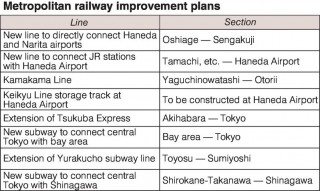Loading
Search
▼ 8 Railway Plans Eyed to Ease Tokyo Travel
- Category:Tourism
The Yomiuri Shimbun
An expert panel under the Land, Infrastructure, Transport and Tourism Ministry has listed eight railway improvement plans in the metropolitan area in its draft of proposals to the government to make Tokyo more competitive as an international city.
The eight projects proposed in the draft, which was released Thursday, include building a new East Japan Railway Co. (JR East) line to connect stations in central Tokyo with Haneda Airport. It also called for extending the Tsukuba Express, and constructing a subway line connecting Tokyo’s central and bay areas.
If realized, the improved rail networks will boost the accessibility of Haneda Airport and the bay area from central Tokyo, but it will be a challenge to secure funds for construction costs.
This is the first time in 16 years that proposals have been made regarding the railway networks in the Tokyo metropolitan area. The last time was in 2000, when the government’s Transport Policy Council compiled similar proposals for improvement projects over the following 15 years.
The latest proposals focus on plans to construct routes connecting central
Tokyo with Haneda Airport. The proposed JR East line, for example, is expected to halve the travel time between the airport and Tokyo, Shinjuku and Shin-Kiba stations.
The panel also proposed joining one of the Tokyu lines and a Keikyu line to connect at Kamata Station near Haneda Airport — thus to be called the Kamakama Line. This is expected to boost accessibility from the western area to the airport.
The draft details the significance of each project along with the challenges. A project to extend a subway line from Shirokane-Takanawa Station to Shinagawa Station, for example, was described as being significant for creating more convenient railway networks in the future. Shinagawa Station will serve as a terminal when a magnetic levitation super high-speed train line is introduced.
In addition to the eight major project proposals, the draft also lists 16 others that it says should be implemented in accordance with the development of areas along railways. They include a project to extend the Toei Oedo subway line from Tokyo’s Nerima Ward to Higashi-Tokorozawa Station in Saitama Prefecture.
It is vital, however, to secure funding to realize these projects. Construction of JR East’s access line to Haneda Airport, for example, is expected to cost about ¥320 billion, and the central and Tokyo metropolitan governments will likely be urged to offer financial support.
An expert panel under the Land, Infrastructure, Transport and Tourism Ministry has listed eight railway improvement plans in the metropolitan area in its draft of proposals to the government to make Tokyo more competitive as an international city.
The eight projects proposed in the draft, which was released Thursday, include building a new East Japan Railway Co. (JR East) line to connect stations in central Tokyo with Haneda Airport. It also called for extending the Tsukuba Express, and constructing a subway line connecting Tokyo’s central and bay areas.
If realized, the improved rail networks will boost the accessibility of Haneda Airport and the bay area from central Tokyo, but it will be a challenge to secure funds for construction costs.
This is the first time in 16 years that proposals have been made regarding the railway networks in the Tokyo metropolitan area. The last time was in 2000, when the government’s Transport Policy Council compiled similar proposals for improvement projects over the following 15 years.
The latest proposals focus on plans to construct routes connecting central
Tokyo with Haneda Airport. The proposed JR East line, for example, is expected to halve the travel time between the airport and Tokyo, Shinjuku and Shin-Kiba stations.
The panel also proposed joining one of the Tokyu lines and a Keikyu line to connect at Kamata Station near Haneda Airport — thus to be called the Kamakama Line. This is expected to boost accessibility from the western area to the airport.
The draft details the significance of each project along with the challenges. A project to extend a subway line from Shirokane-Takanawa Station to Shinagawa Station, for example, was described as being significant for creating more convenient railway networks in the future. Shinagawa Station will serve as a terminal when a magnetic levitation super high-speed train line is introduced.
In addition to the eight major project proposals, the draft also lists 16 others that it says should be implemented in accordance with the development of areas along railways. They include a project to extend the Toei Oedo subway line from Tokyo’s Nerima Ward to Higashi-Tokorozawa Station in Saitama Prefecture.
It is vital, however, to secure funding to realize these projects. Construction of JR East’s access line to Haneda Airport, for example, is expected to cost about ¥320 billion, and the central and Tokyo metropolitan governments will likely be urged to offer financial support.
- April 8, 2016
- Comment (0)
- Trackback(0)


